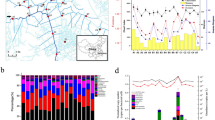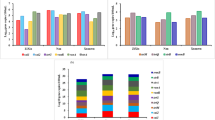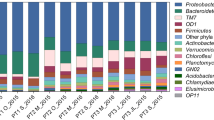Abstract
Wastewater treatment plants (WWTPs) with additional tertiary ultrafiltration membranes and ozonation treatment can improve water quality in receiving rivers. However, the impacts of WWTP upgrade (WWTP-UP) on pathogens carrying antibiotic resistance genes (ARGs) and virulence factors (VFs) in rivers remain poorly understood. In this study, ARGs, VFs, and their pathogenic hosts were investigated in three rivers impacted by large-scale WWTP-UP. A five-year sampling campaign covered the periods before and after WWTP-UP. Results showed that the abundance of total metagenome-assembled genomes (MAGs) containing both ARGs and VFs in receiving rivers did not decrease substantially after WWTP-UP, but the abundance of MAGs belonging to pathogenic genera that contain both ARGs and VFs (abbreviated as PAVs) declined markedly. Genome-resolved metagenomics further revealed that WWTP-UP not only reduced most types of VFs and ARGs in PAVs, but also effectively eliminated efflux pump and nutritional VFs carried by PAVs in receiving rivers. WWTP-UP narrowed the pathogenic host ranges of ARGs and VFs and mitigated the cooccurrence of ARGs and VFs in receiving rivers. These findings underline the importance of WWTP-UP for the alleviation of pathogens containing both ARGs and VFs in receiving rivers.

Similar content being viewed by others
References
Alneberg J, Bjarnason B S, de Bruijn I, Schirmer M, Quick J, Ijaz U Z, Lahti L, Loman N J, Andersson A F, Quince C (2014). Binning metagenomic contigs by coverage and composition. Nature Methods, 11(11): 1144–1146
Balcázar J L, Subirats J, Borrego C M (2015). The role of biofilms as environmental reservoirs of antibiotic resistance. Frontiers in Microbiology, 6: 1216
Biswal B K, Mazza A, Masson L, Gehr R, Frigon D (2014). Impact of wastewater treatment processes on antimicrobial resistance genes and their co-occurrence with virulence genes in Escherichia coli. Water Research, 50: 245–253
Cheng X, Xu J, Smith G, Nirmalakhandan N, Zhang Y (2021). Metagenomic profiling of antibiotic resistance and virulence removal: Activated sludge vs. Algal wastewater treatment system. Journal of Environmental Management, 295: 113129
Chu B T T, Petrovich M L, Chaudhary A, Wright D, Murphy B, Wells G, Poretsky R (2018). Metagenomics reveals the impact of wastewater treatment plants on the dispersal of microorganisms and genes in aquatic sediments. Applied and Environmental Microbiology, 84(5): e02168–17
Das D, Bordoloi A, Achary M P, Caldwell D J, Suri R P S (2022). Degradation and inactivation of chromosomal and plasmid encoded resistance genes/ARBs and the impact of different matrices on UV and UV/H2O2 based advanced oxidation process. Science of the Total Environment, 833: 155205
Eaves D J, Ricci V, Piddock L J V (2004). Expression of acrB, acrF, acrD, marA, and soxS in salmonella enterica serovar typhimurium: Role in multiple antibiotic resistance. Antimicrobial Agents and Chemotherapy, 48(4): 1145–1150
Eggen R I L, Hollender J, Joss A, Schärer M, Stamm C (2014). Reducing the discharge of micropollutants in the aquatic environment: the benefits of upgrading wastewater treatment plants. Environmental Science & Technology, 48(14): 7683–7689
Gao T W, Xiao K, Zhang J, Xue W C, Wei C H, Zhang X P, Liang S, Wang X M, Huang X (2022). Techno-economic characteristics of wastewater treatment plants retrofitted from the conventional activated sludge process to the membrane bioreactor process. Frontiers of Environmental Science & Engineering, 16(4): 49
Gu D, Dong N, Zheng Z, Lin D, Huang M, Wang L, Chan E W C, Shu L, Yu J, Zhang R, Chen S (2018). A fatal outbreak of ST11 carbapenem-resistant hypervirulent Klebsiella pneumoniae in a Chinese hospital: a molecular epidemiological study. Lancet. Infectious Diseases, 18(1): 37–46
Harnisz M, Kiedrzyńska E, Kiedrzyński M, Korzeniewska E, Czatzkowska M, Koniuszewska I, Jóźwik A, Szklarek S, Niestępski S, Zalewski Mm (2020). The impact of WWTP size and sampling season on the prevalence of antibiotic resistance genes in wastewater and the river system. Science of the Total Environment, 741: 140466
Ho Sui S J, Fedynak A, Hsiao W W L, Langille M G I, Brinkman F S L (2009). The association of virulence factors with genomic islands. PLoS One, 4(12): e8094
Hu Y, Yang X, Qin J, Lu N, Cheng G, Wu N, Pan Y, Li J, Zhu L, Wang X, Meng Z, Zhao F, Liu D, Ma J, Qin N, Xiang C, Xiao Y, Li L, Yang H, Wang J, Yang R, Gao G F, Wang J, Zhu B (2013). Metagenome-wide analysis of antibiotic resistance genes in a large cohort of human gut microbiota. Nature Communications, 4(1): 2151
Hu Y R, Zhang T Y, Jiang L, Luo Y, Yao S J, Zhang D, Lin K, Cui C (2019). Occurrence and reduction of antibiotic resistance genes in conventional and advanced drinking water treatment processes. Science of the Total Environment, 669: 777–784
Hyatt D, Chen G L, LoCascio P F, Land M L, Larimer F W, Hauser L J (2010). Prodigal: prokaryotic gene recognition and translation initiation site identification. BMC Bioinformatics, 11(1): 119
Iakovides I C, Michael-Kordatou I, Moreira N F F, Ribeiro A R, Fernandes T, Pereira M F R, Nunes O C, Manaia C M, Silva A M T, Fatta-Kassinos D (2019). Continuous ozonation of urban wastewater: Removal of antibiotics, antibiotic-resistant Escherichia coli and antibiotic resistance genes and phytotoxicity. Water Research, 159: 333–347
Jäger T, Hembach N, Elpers C, Wieland A, Alexander J, Hiller C, Krauter G, Schwartz T (2018). Reduction of antibiotic resistant bacteria during conventional and advanced wastewater treatment, and the disseminated loads released to the environment. Frontiers in Microbiology, 9: 2599
Jain C, Rodríguez-R L, Phillippy M, Konstantinidis A T K, Aluru S (2018). High throughput ANI analysis of 90K prokaryotic genomes reveals clear species boundaries. Nature Communications, 9(1): 5114
Jiao Y N, Chen H, Gao R X, Zhu Y G, Rensing C (2017). Organic compounds stimulate horizontal transfer of antibiotic resistance genes in mixed wastewater treatment systems. Chemosphere, 184: 53–61
Josenhans C, Suerbaum S (2002). The role of motility as a virulence factor in bacteria. International Journal of Medical Microbiology, 291(8): 605–614
Ju F, Li B, Ma L P, Wang Y B, Huang D P, Zhang T (2016). Antibiotic resistance genes and human bacterial pathogens: co-occurrence, removal, and enrichment in municipal sewage sludge digesters. Water Research, 91: 1–10
Kang D W D, Li F, Kirton E, Thomas A, Egan R, An H, Wang Z (2019). MetaBAT 2: an adaptive binning algorithm for robust and efficient genome reconstruction from metagenome assemblies. PeerJ, 7: e7359
Keum J W, Bermudez H (2009). Enhanced resistance of DNA nanostructures to enzymatic digestion. Chemical Communications (Cambridge), 7(45): 7036–7038
Le T H, Ng C, Tran N, Chen H, Gin K Y (2018). Removal of antibiotic residues, antibiotic resistant bacteria and antibiotic resistance genes in municipal wastewater by membrane bioreactor systems. Water Research, 145: 498–508
Leclerc H, Moreau A (2002). Microbiological safety of natural mineral water. FEMS Microbiology Reviews, 26(2): 207–222
Lemos L N, Pereira R V, Quaggio R B, Martins L F, Moura L M S, da Silva A R, Antunes L P, da Silva A M, Setubal J C (2017). Genome-centric analysis of a thermophilic and cellulolytic bacterial consortium derived from composting. Frontiers in Microbiology, 8: 644
Li D, Liu C M, Luo R, Sadakane K, Lam T W (2015). MEGAHIT: an ultra-fast single-node solution for large and complex metagenomics assembly via succinct de Bruijn graph. Bioinformatics (Oxford, England), 31(10): 1674–1676
Liang J, Mao G, Yin X, Ma L, Liu L, Bai Y, Zhang T, Qu J (2020). Identification and quantification of bacterial genomes carrying antibiotic resistance genes and virulence factor genes for aquatic microbiological risk assessment. Water Research, 168: 115160
Lin Z J, Zhou Z C, Zhu L, Meng L X, Shuai X Y, Sun Y J, Chen H (2021). Behavior of antibiotic resistance genes in a wastewater treatment plant with different upgrading processes. Science of the Total Environment, 771: 144814
Liu B, Zheng D D, Jin Q, Chen L H, Yang J (2019). VFDB 2019: a comparative pathogenomic platform with an interactive web interface. Nucleic Acids Research, 47(D1): D687–692
Lüddeke F, Heß S, Gallert C, Winter J, Güde H, Löffler H (2015). Removal of total and antibiotic resistant bacteria in advanced wastewater treatment by ozonation in combination with different filtering techniques. Water Research, 69: 243–251
Majeed H J, Riquelme M V, Davis B C, Gupta S, Angeles L, Aga D S, Garner E, Pruden A, Vikesland P J (2021). Evaluation of metagenomic-enabled antibiotic resistance surveillance at a conventional wastewater treatment plant. Frontiers in Microbiology, 12: 657954
Mao D Q, Luo Y, Mathieu J, Wang Q, Feng L, Mu Q H, Feng C Y, Alvarez P J J (2014). Persistence of extracellular DNA in river sediment facilitates antibiotic resistance gene propagation. Environmental Science & Technology, 48(1): 71–78
Nguyen A Q, Vu H P, Nguyen L N, Wang Q L, Djordjevic S P, Donner E, Yin H B, Nghiem L D (2021). Monitoring antibiotic resistance genes in wastewater treatment: Current strategies and future challenges. Science of the Total Environment, 783: 146964
Pan Y, Zeng J, Li L, Yang J, Tang Z, Xiong W, Li Y, Chen S, Zeng Z (2020). Coexistence of antibiotic resistance genes and virulence factors deciphered by large-scale complete genome analysis. mSystems, 5(3): e00821–19
Parks D H, Chuvochina M, Waite D W, Rinke C, Skarshewski A, Chaumeil P A, Hugenholtz P (2018). A standardized bacterial taxonomy based on genome phylogeny substantially revises the tree of life. Nature Biotechnology, 36(10): 996–1004
Penttinen R, Kinnula H, Lipponen A, Bamford J K, Sundberg L R (2016). High nutrient concentration can induce virulence factor expression and cause higher virulence in an environmentally transmitted pathogen. Microbial Ecology, 72(4): 955–964
Piotrowska M, Popowska M (2014). The prevalence of antibiotic resistance genes among aeromonas species in aquatic environments. Annals of Microbiology, 64(3): 921–934
Riquelme Breazeal M V, Novak J T, Vikesland P J, Pruden A (2013). Effect of wastewater colloids on membrane removal of antibiotic resistance genes. Water Research, 47(1): 130–140
Stamm C, Rasanen K, Burdon F J, Altermatt F, Jokela J, Joss A, Ackermann M, Eggen R I L (2016). Unravelling the impacts of micropollutants in aquatic ecosystems: interdisciplinary studies at the interface of large-scale ecology. Advances in Ecological Research, 55: 183–223
Stange C, Sidhu J P S, Toze S, Tiehm A (2019). Comparative removal of antibiotic resistance genes during chlorination, ozonation, and UV treatment. International Journal of Hygiene and Environmental Health, 222(3): 541–548
Su D, Ben W, Strobel B W, Qiang Z (2021). Impacts of wastewater treatment plant upgrades on the distribution and risks of pharmaceuticals in receiving rivers. Journal of Hazardous Materials, 406: 124331
Tang J Y, Bu Y Q, Zhang X X, Huang K L, He X W, Ye L, Shan Z J, Ren H Q (2016). Metagenomic analysis of bacterial community composition and antibiotic resistance genes in a wastewater treatment plant and its receiving surface water. Ecotoxicology and Environmental Safety, 132: 260–269
Tavares R D S, Tacao M, Figueiredo A S, Duarte A S, Esposito F, Lincopan N, Manaia C M, Henriques I (2020). Genotypic and phenotypic traits of blaCTX-M-carrying Escherichia coli strains from an UV-C-treated wastewater effluent. Water Research, 184: 116079
Varela A R, Manaia C M (2013). Human health implications of clinically relevant bacteria in wastewater habitats. Environmental Science and Pollution Research International, 20(6): 3550–3569
Wang H, Xu J, Tang W, Li H, Xia S, Zhao J, Zhang W X, Yang Y (2019). Removal efficacy of opportunistic pathogens and bacterial community dynamics in two drinking water treatment trains. Small, 15:1804436
Wang Q, Liang J, Zhao C, Bai Y, Liu R, Liu H, Qu J (2020). Wastewater treatment plant upgrade induces the receiving river retaining bioavailable nitrogen sources. Environmental Pollution, 263:114478
Wu Y W, Simmons B A, Singer S W (2016). MaxBin 2.0: an automated binning algorithm to recover genomes from multiple metagenomic datasets. Bioinformatics (Oxford, England), 32(4): 605–607
Yang L, Wen Q X, Chen Z Q, Duan R, Yang P (2019). Impacts of advanced treatment processes on elimination of antibiotic resistance genes in a municipal wastewater treatment plant. Frontiers of Environmental Science & Engineering, 13(3): 32
Yin X, Jiang X T, Chai B, Li L, Yang Y, Cole J R, Tiedje J M, Zhang T (2018). ARGs-OAP v2.0 with an expanded SARG database and Hidden Markov Models for enhancement characterization and quantification of antibiotic resistance genes in environmental metagenomes. Bioinformatics (Oxford, England), 34(13): 2263–2270
Yuan Q B, Huang Y M, Wu W B, Zuo P, Hu N, Zhou Y Z, Alvarez P J J (2019). Redistribution of intracellular and extracellular free & adsorbed antibiotic resistance genes through a wastewater treatment plant by an enhanced extracellular DNA extraction method with magnetic beads. Environment International, 131: 104986
Zhang B, Xia Y, Wen X H, Wang X H, Yang Y F, Zhou J Z, Zhang Y (2016). The composition and spatial patterns of bacterial virulence factors and antibiotic resistance genes in 19 wastewater treatment plants. PLoS One, 11(12): e0167422
Zhang J, Yu D, Dian L, Hai Y, Xin Y, Wei Y (2022). Metagenomics insights into the profiles of antibiotic resistome in combined sewage overflows from reads to metagenome assembly genomes. Journal of Hazardous Materials, 429: 128277
Zhao J, Li B, Lv P, Hou J, Qiu Y, Huang X (2022). Distribution of antibiotic resistance genes and their association with bacteria and viruses in decentralized sewage treatment facilities. Frontiers of Environmental Science & Engineering, 16(3): 35
Acknowledgements
This work was supported by the National Natural Science Foundation of China (42101128, 51578537, and 51778603) and Chinese Academy of Sciences (QYZDY-SSW-DQC004). The authors thank the Beijing Genomics Institute Central China for providing high-throughput sequencing services.
Author information
Authors and Affiliations
Corresponding author
Additional information
Highlights
• Abundance of MAGs carrying ARG-VF pairs unchanged in rivers after WWTP upgrade.
• Upgrade of WWTPs significantly reduced diversity of pathogenic genera in rivers.
• Upgrade of WWTPs reduced most VF (ARG) types carried by potential pathogens in rivers.
• Upgrade of WWTPs narrowed the pathogenic host ranges of ARGs and VFs in rivers.
Supporting Information
11783_2023_1682_MOESM1_ESM.pdf
Mitigating microbiological risks of potential pathogens carrying antibiotic resistance genes and virulence factors in receiving rivers: Benefits of wastewater treatment plant upgrade
Rights and permissions
About this article
Cite this article
Mao, G., Wang, D., Bai, Y. et al. Mitigating microbiological risks of potential pathogens carrying antibiotic resistance genes and virulence factors in receiving rivers: Benefits of wastewater treatment plant upgrade. Front. Environ. Sci. Eng. 17, 82 (2023). https://doi.org/10.1007/s11783-023-1682-4
Received:
Revised:
Accepted:
Published:
DOI: https://doi.org/10.1007/s11783-023-1682-4




